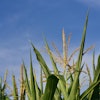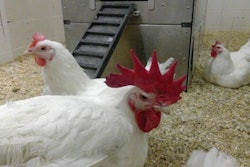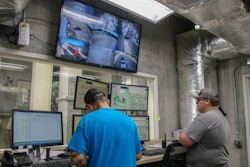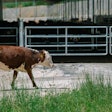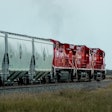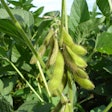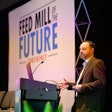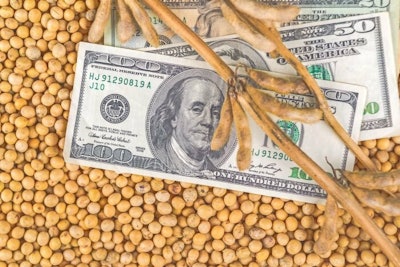
Feed manufacturers that emphasize their product’s environmental metrics, low-carbon footprint and sustainable ingredient sourcing will be able to charge more
Fishermen in the business of feed production are no strangers to a very literal definition of the word “sustainability.” It was in the 1990s, Brett Glencross recalls, that the industry came to realize the amount of fishmeal wild fish could produce was finite, prompting researchers and entrepreneurs to mobilize in pursuit of alternatives.
Today the amount of fishmeal included in feed has stabilized around 10% to 15%, says Glencross, a professor of aquaculture nutrition at the University of Stirling in Scotland and technical director for The Marine Ingredients Organization (IFFO). But the vast majority of the reduction in marine ingredients, he says, was replaced with plant materials — primarily soy. In the process, the feed industry may have inadvertently increased the total carbon footprint of aquafeed.
Soy and fishmeal are, arguably, the most vilified feed ingredients from an environmental perspective, and yet both industries believe they have much to gain from the increased focus on sustainability.
As animal agriculture responds to pressure to decrease sector-wide carbon emissions, environmental metrics have begun to factor into feed purchasing decisions alongside cost and growth performance. The need to make more effective comparisons is driving efforts to collect more accurate, transparent data — and that, Glencross says, may help not only to dispel some common misconceptions about consumers’ least favorite ingredients, but could also give feed ingredient producers a new marketing tool.
“This is going to be a monetizable aspect of ingredients in the future,” he says. “Those products with a low carbon footprint will command a premium because of it.”
The carbon conundrum
For soy, the conversation about sustainability began about 10-15 years ago with questions about land use, deforestation and biodiversity, according to Abby Rinne, director of sustainability at the U.S. Soybean Export Council (USSEC). By 2014, USSEC had formalized its U.S. Soy Sustainability Protocol, which established four goals for soybean production: 25% less soil erosion, 10% more land efficiency, 10% more energy efficiency and 10% fewer emissions of greenhouse gases.
The U.S. Soy Sustainability Protocol was, perhaps, somewhat ahead of its time — only 6,000 metric tons of soybeans were certified when the program began. By 2021, 28.4 million metric tons of certified soy shipped to 37 different companies that use it to market some 850 products as more sustainable than their peers.
But since the protocol’s adoption, the conversation around sustainability has also changed, Rinne says.
About three years ago, she says, USSEC enlisted the help of Blonk Consultants to begin drawing up estimates to answer what had by then become the most frequent question USSEC heard from soybean buyers: What was the carbon footprint of their beans?
The initial intent, Rinne says, was to compare U.S.-grown soybeans to those produced in other soy-producing countries. In the end, the analysis concluded that the U.S. generally had a slight advantage over other regions that must rely more heavily on trucks, rather than rail or barge transportation, to move soybeans. But generally, Rinne says, the difference was rather slim. Countries with access to more efficient equipment and fertilizers generally shared comparable rates of carbon emissions.
The next phase of research will compare soy to other plant-based sources of protein and oil. The results aren’t complete yet, but Rinne remains confident that their research will prove soy has the lowest carbon footprint of common plant proteins.
Yet in the fishmeal industry, Glencross believes essentially the same thing about fishmeal.
“What we know from experience with the data that is already out there,” he says, is that the carbon footprint of fishmeal “is really good. It’s got a lower carbon footprint than almost anything out there — lower than insect meal or plant meal.”
Herein lies one of the problems that producers of sustainable animal feed currently face: Just because a supplier has carbon data to offer, doesn’t mean you can compare one figure to the next.
Collecting the data
While there may be some contexts — power plants, for example — where it would be possible to stick a monitor in a smokestack to measure how much carbon comes out, estimating the carbon emissions created in the production of a product like soybeans or fishmeal is far more difficult. Emissions are not only spread out across a much wider area — there’s no one single smoke stack from which they arise — but the number of variables that goes into the process is also greater, according to Marty Heller, a senior consultant with Blonk.
And while it might be nice to track and survey every farmer about how much diesel or fertilizer they use, that kind of information just isn’t available. So experts like Heller must rely on estimates.
The thing is, there’s no set of agreed-upon rules outlining how the carbon footprint of a commodity like soybeans or fishmeal is supposed to be estimated. The EU is gradually winding its way toward some standardizing regulation, Heller says, but there’s little activity on this front in the U.S. and elsewhere.
Companies interested in incorporating environmental data into their decision matrix have already begun to work on solutions of their own. Alltech, for example, has developed its own software and processes that allow it to measure the impact of feed formulations. This enables the company to compare crops and evaluate different feed formulations internally — and to offer consultations to customers looking to cut back on carbon, according to Ben Braou, general manager of Alltech E-CO2.
Independent software can also be purchased, but like any internal analysis or system, will only be as good as the data it contains — and comparisons to outside models may be difficult.
In late 2020, a coalition assembled by the European Feed Manufacturer’s Federation (FEFAC), the American Feed Industry Association (AFIA), the Animal Nutrition Association of Canada (ANAC), and the International Feed Industry Federation (IFIF) launched the Global Feed LCA Institute (GFLI) to solve this precise problem.
The nonprofit aims to become an independent clearinghouse of publicly available data on the life cycle assessment (LCA) — or the end-to-end environmental performance.
Incentivizing impact
The GFLI has quickly become an important reference across the industry, with experts at Alltech and Blonk already drawing on its work. Yet the GFLI, Glencross says, is only just beginning. He and others believe the database will only grow more powerful — and potentially more useful — as the effort to expand it continues.
The GFLI is not yet comprehensive; it does not yet contain data on all possible feed ingredients, and the data available generally represent global or regional averages.
The next step, in addition to adding more diverse ingredients, is adding more specific data, Glencross says, not just the average carbon emissions associated with fishmeal, but the average emissions from fishmeal from specific fisheries. And, eventually, from specific producers. Blockchain and other technologies, Braou says, could further increase transparency about the production and movement of feed ingredients, bringing emissions estimates for feed ever-closer to absolute, real-world data.
Once the data reaches this level of detail, Glencross says, feed inputs could begin to compete not just on cost or performance, but also on their environmental benefits.
By creating monetary incentives for sustainable products, collecting more granular carbon data would also yield environmental benefits, Glencross says. Take byproducts, for example. For decades, most people have turned up their noses at the idea of consuming what could be considered waste. But byproducts such as the trimmings off a high-quality tuna or salmon could have a very low carbon footprint and, thus, could be considered quite valuable to the right buyer.
Selling those byproducts as low-carbon fishmeal could not only help expand the global supply of fishmeal, solving a longstanding problem and reducing waste in one swift move.
So while increasing the uniformity of carbon data might initially cause some hiccups for the multiple parties trying to claim they have the lowest-carbon feed input available, Glencross believes it’s ultimately critical to the industry’s future.
“Everybody is basically getting on board with this concept of finding a way to provide clear and objective rules and frameworks around the way in which we measure carbon costs and all those other metrics, and to do it in a clear and transparent way, where someone independent collects the data,” Glencross says. “Because the worst thing that could happen is a whole series of data gets collected, and then the world turns around and says, ‘we think you fudged the numbers.’”
Announcing the Feed Mill of the Future digital supplement
WATT’s feed brands Feed Strategy and Feed & Grain magazines join forces to launch the monthly Feed Mill of the Future digital supplement. Each edition aims to provide animal feed industry stakeholders with forward-looking content, market insights and a spotlight on the leading-edge technologies shaping the global feed industry of tomorrow.
Subscribe today! https://bit.ly/3dWzow7

